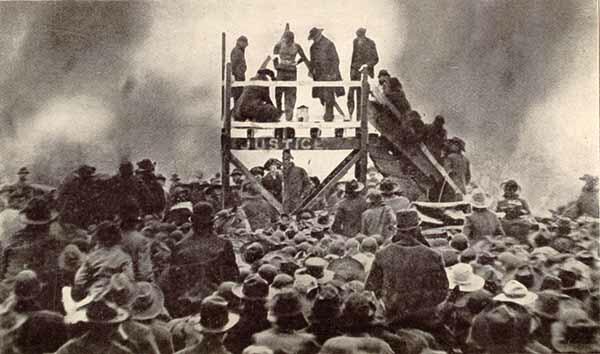By Jack El-Hai, Wonders & Marvels contributor
Eighty years ago, racially motivated lynching in the U.S. was disturbingly common — there were 20 lynchings reported in 1935. Among its many activities intended to call attention to the injustice and brutality of these public murders, the National Association for the Advancement of Colored People (NAACP) sponsored an art exhibition in New York City. It was the first display of art in the U.S. organized around the themes of lynching and discrimination against African-American men. At the time, few galleries anywhere in America showed art by black artists or works that explored racial themes.
Titled An Art Commentary on Lynching, the show ran from February 13 through March 2, 1935, in the Arthur U. Newton Galleries in Midtown Manhattan. (Its home was originally to be the Jacques Seligmann Galleries, but the management there backed out.) It was a pet project of NAACP director Walter White, who wanted to build support for legislation to make lynching a federal crime.
The 38 artists whose works appeared in the exhibition included one woman (Peggy Bacon) and ten African Americans. White asked each of the contributors to focus on the violence of lynching, no matter how disturbing the result may be for visitors. And White got what he wanted: a collection of works laden with gore, terror, and hatred. (A few of the artists used milder religious imagery.) About 3,000 people took it all in.
Visitors saw John Steuart Curry’s lithograph The Fugitive, Isamu Noguchi’s sculpture Death, Harry Sternberg’s lithograph Southern Holiday, Thomas Hart Benton’s painting A Lynching, Wilmer Jennings’s linocut At the End of the Rope, and Peggy Bacon’s caricatures of infamous Southern judges, among other memorable works. Much of the exhibition’s featured art has not survived to the present day, and many of their creators have disappeared into obscurity.
White hoped that the creation and display of these artworks would heighten the public’s awareness of lynching and increase the general outrage. In the end, while his advocacy opened some eyes and generated a little news coverage it failed to bring about the passage of any federal anti-lynching legislation. His work to launch An Art Commentary on Lynching on a national tour also never came to fruition.
Further reading:
Dray, Philip. At the Hands of Persons Unknown: The Lynching of Black America. Random House, 2002.
Vendryes, Margaret Rose. “Hanging on Their Walls: An Art Commentary on Lynching, the Forgotten 1935 Art Exhibition,” published in Race Consciousness: African-American Studies for the New Century, edited by Judith Jackson Fossett and Jeffrey A. Tucker. New York University Press, 1997.

